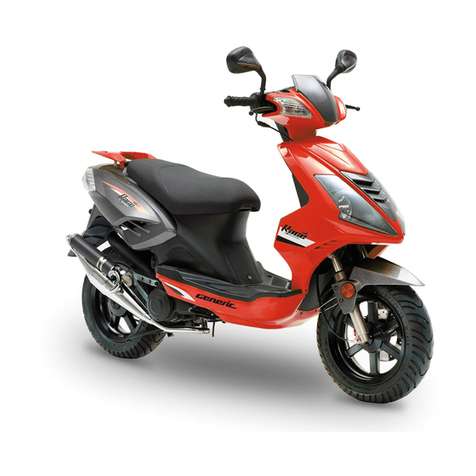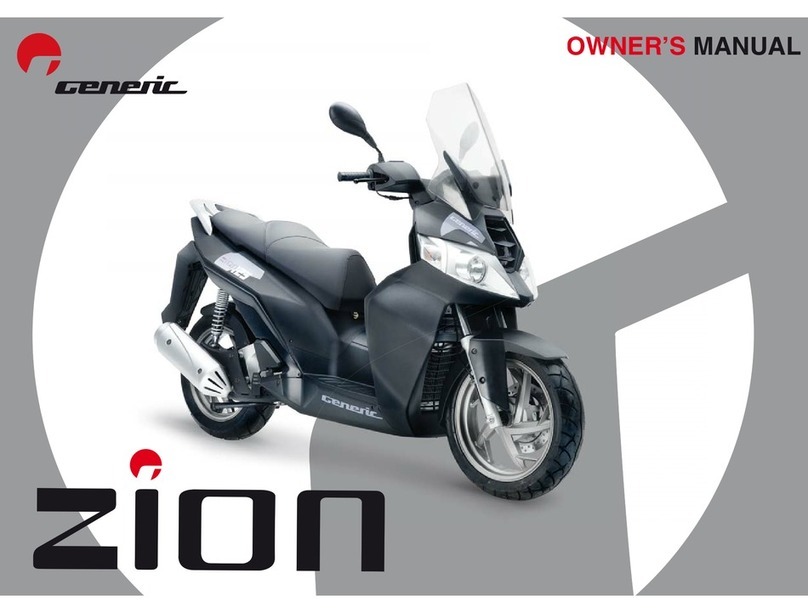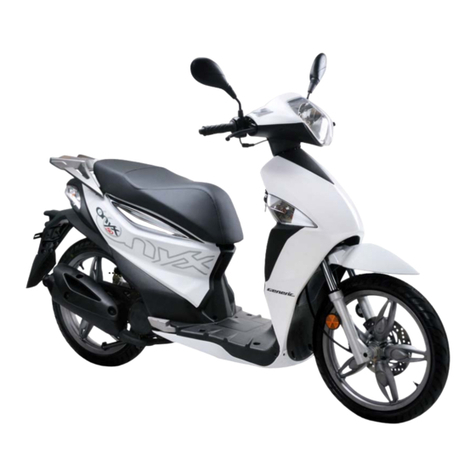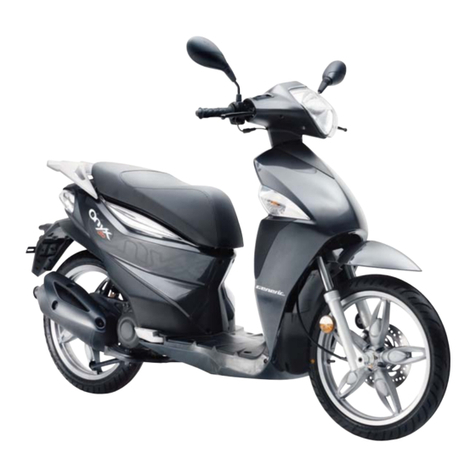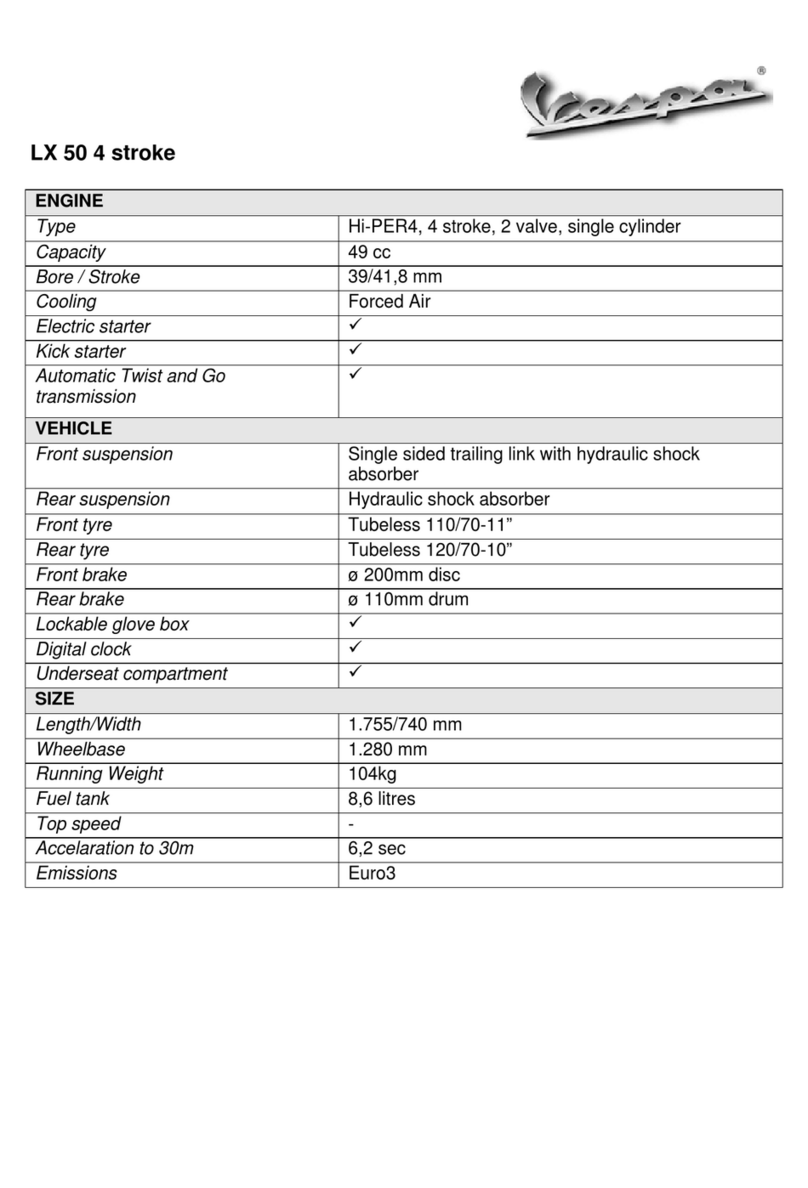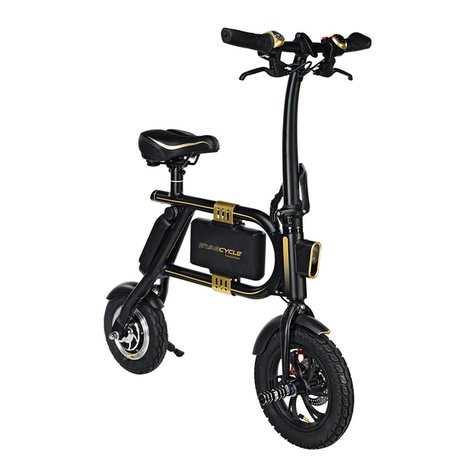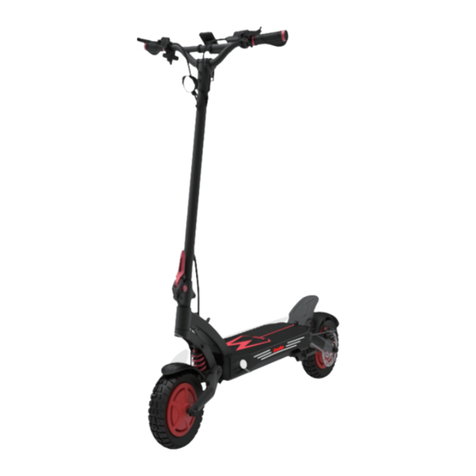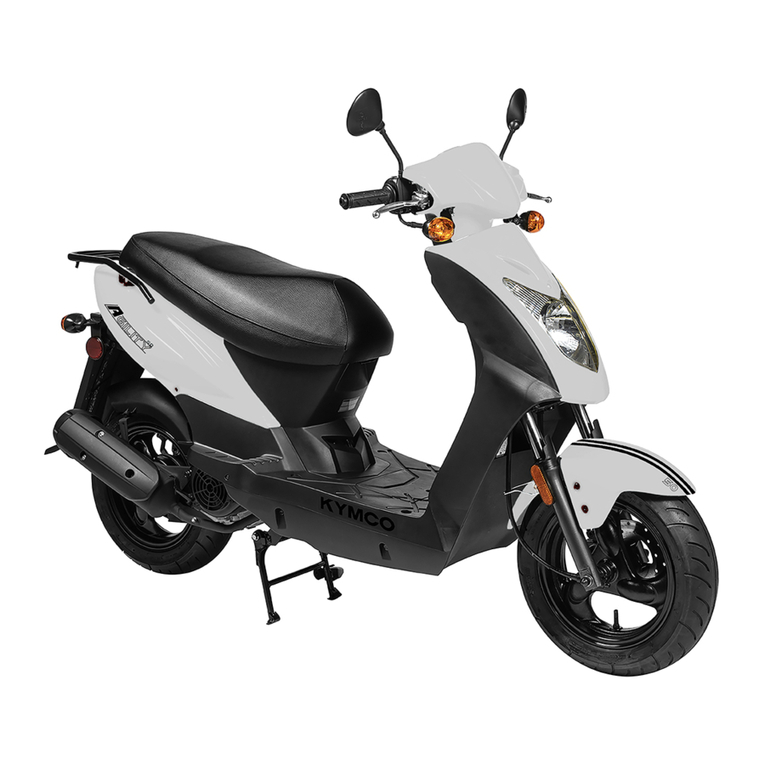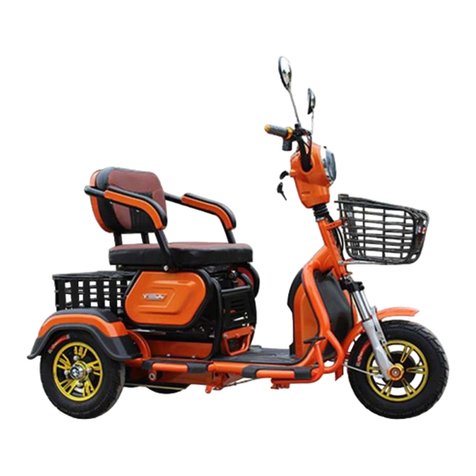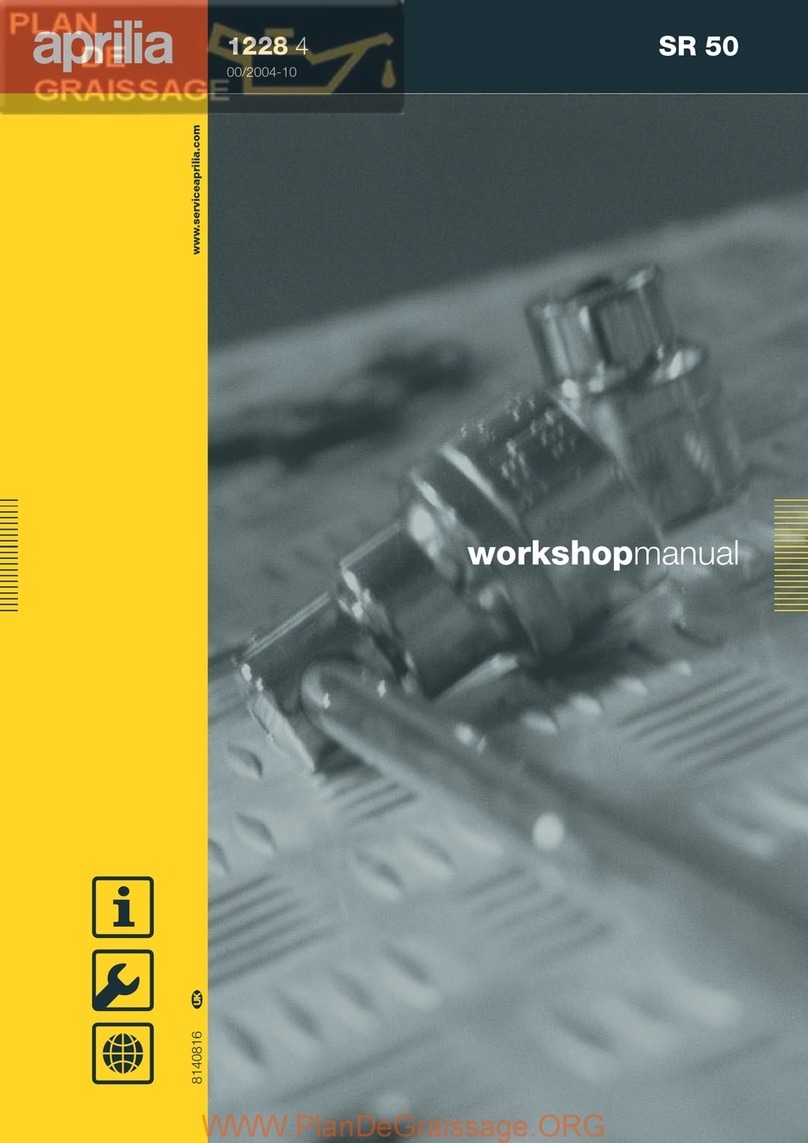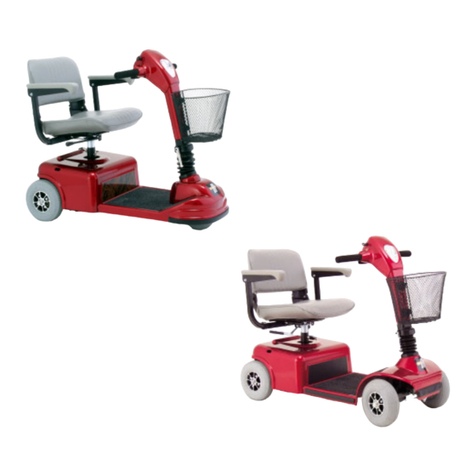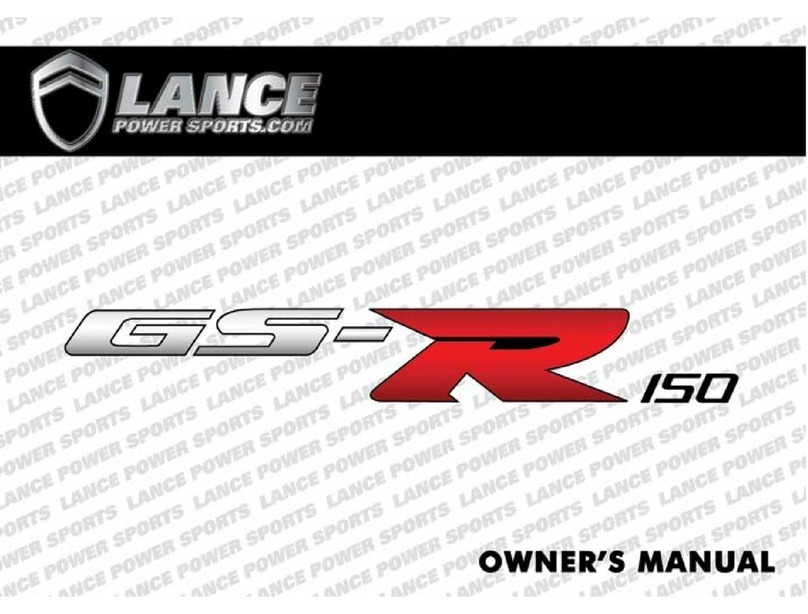Generic XOR 125 User manual

Service Manual
Holtvej 8-10, Høruphav, 6470 Sydals
Telefon: +45 73 15 11 00
Fax: +45 73 15 11 01
CVR: 27 73 31 07
November 2010
XOR 125
Maxi scooter

1
PREFACE
The service manual has been specially prepared to provide all the necessary information for the proper
maintenance and servicing.
You have now a new type of scooter that has many techinal features such as:
V-belt drive automatic transmission
Forced air-cooling system
CDI ignition system
Electric starter system
Those who will be servicing the scooter should carefully review the manual before performing any repair or
services. Major modifications and changes incorporated later will be advised to GENERIC product distributor in
each market. Therefore, if newest information is requested in the future, please contact the local GENERIC
distributor.
The scooters distributed in your country mignt differ in minor respects from the standard specification and, if they
do, it is because some minor modifications had to be made to comply with the statutory requirements of your
country.

2
GENERAL INFORMATION
TYPE IDENTIFICATION
FUEL AND ENGINE OIL
BREAK-IN PROCEDURE
PRECAUTIONS AND GENERAL INSTRUCTIONS
SPECIFICATIONS
CONTENT

3
TYPE IDENTIFICATION
ENGINE NUMBER
ENGINE NUMBER ①is carved on rear crankcase as
Shown in figure.
Both FRAME NUBER AND ENGINE NUMBER are designed specially for registering your scooter and ordering
spare parts.
FUEL AND ENGINE OIL
Be sure to use specified fuel and engine oil.
Some specifications are as follows:
FUEL
Unleaded, the minimum octane number is 95 or more.
ENGINE OIL
For GENERIC SYSTEM, we recommend special engine oil, you can choose high quality Four-stroke engine oil
(SHELL ULTRA 4 – 15W40)
GEAR OIL
Use high quality, all-purpose 80W90 engine oil for your vehicle.
BREAK-IN TIME
General requirements are as follows:
Limit break-in speed:
At the first 100KMS mileage,play throttle less than 4/5 throttle;
Don’t run engine too long during break-in time, and try to change throttle position.
1

4
PRECAUTIONS AND GENERAL INSTRUCTIONS
•Correctly abide by the following items when disassembling and assembling scooter:
•Don’t run engine indoors without ventilation;
•Be sure to replace new bushings, circlips, O-rings and cotter pins with new ones;
CAUTION
•It is forbidden to use the circlip removed from shaft again, only use new one;
•Be very carefull to install new circlip for fear that the end hatch of circlip exceeds required sliding surface
for shaft;
•After installing circlip, inspect whether it has been completely clipped into the groove.
•Fix bigger diameter bolt first when tightening cylinder head or cylinder, and tighten to specified torque
gradually from inside to outside at diagonal order.
•Use special tools for some special requirements;
•Use original components and recommended engine oil;
•Keep each other’s safety when several persons do;
•Inspect looseness and operating state of components after reassembling them.;
•Take high care of gasoline, which is explosive, and never use gasoline as lotion.
The words like warning, notice, note may turn out incessantly in the manual, which means:
WARNING The personal safety of the rider may be involved. Disregarding the information could result in injury
to the rider.
CAUTION These instructions point out special service procedures or precautions that must be followed to
avoid damaging the machine.
NOTE it provides some special information, which keeps maintenance easier and important instructions
clearer..
REPLACEMENT COMPONENTS
Be sure to use genuine GENERIC components or their equivalent.. Genuine GENERIC components are high
quality parts which are designed specially for your vehicle.
CAUTION
Damage to the scooter may result from use of replacement components which are not Equivalent in quality to
genuine GENERIC parts, and it can lead to performance problems.

5

6
SPECIFICATIONS
DIMENSION AND NET WEIGHT
OVERALL LENGTH 1770 mm
OVERALL WIDTH 702 mm
OVERALL HEIGHT 1085 mm
WHEELBASE 1280 mm
NET WEIGHT 100 kg
CHASSIS
Front shock absorber spring, oil damp
Rear shock absorber spring, oil damp
Front wheel 120/70-12
Rear wheel 130/70-12
Front brake Discφ190
Rear brake Drumφ110
ENGINE
Type four-stroke, air cooled
Intake system piston-reed valve
Cylinder QTY. 1
Bore 52.4mm
Stroke 57.8mm
Discharge 124.6ccm
Compression ratio 9.5:1
Air cleaner dry
Starting system electric and kicking start
Lubricating systempressure lubricating
ELECTRIC
Ignition mode CDI
Spark plug CR7HSA
Storage battery YTX7L-BS
Generator AC magneto
Fuse 15A
Headlight 12V—35/35W
Turning light 12V/10W
Taillight 12V—21/5W
CAPACITY
FUELTANK 5.2L
ENGINE OIL TANK 1L
GEAROIL 0.1L
Transmission system
Clutch system dry auto a centric
Gearshift mechanism CVT stepless
Operating mode of gears shift mechanism
Automatic a centric
Step less shift range 0.86~2.64
*the above data may be modified without any
notification.

7
Periodic maintenance and service
Periodic maintenance and service schedule
Maintenance and service procedures
Storage battery
Spark plug
Cylinder head nut and exhaust pipe bolt
Cylinder head and cylinder
Fuel level line
Air cleaner
Throttle cable
Engine idle speed
Oil pump
Gear oil
Braking
Tire
Steering
Front shock absorber
Rear shock absorber
Vehicle bolts and nuts
CONTENTS

8
Periodic maintenance and service schedule
The following table lists all required intervals for maintenance and service,following which, you are assured to have
your scooter perform in the best way.
Note
Do more frequent maintenance when often riding on bad road
Periodic maintenance table
PERIODICAL MAINTENANCE SCHEDULE
Maintenance
Kilometres
Item
Check Items
500KM 3500KM 6500KM 9500KM 12500KM 15500KM 18500KM 21500KM Remarks
1 Air cleaner element I C R C R C
2 Air cleaner I C R
3 Tire pressure I I I I I I I I
4 Battery I I I I I I I I
5 Spark plug I I I I R I R I
6 Carburettor (idle speed) I I I I
7 Steering bearing and handles I I
8 Transmission oil R Replace all 6000Km or once a year
9 Engine oil R Replace all 3000km
10 Drive belt I I R I R
11 Fuel tank switch and lines I I I I
12 Throttle valve operation and cable I I I I R I I R
13 Engine bolts and nuts I I I I
14 piston Replace all 12500Km
15 Exhaust system I
16 Shock absorbers I I I
17 Front/rear suspension I I I
18 Main/side stand I L L I/L L L I/L L
19 Brake mechanism/brake pads I I I I I I I I
20 Bolts/nuts for each component I I I I
The above maintenance schedule is established by taking the monthly 800 kilometers as a reference which ever comes
first.
Have your motorcycle checked and adjusted periodically by your GENERIC Authorized Dealer to maintain the
motorcycle at the optimum condition.
Code: I ~ Inspection, cleaning, and adjustment R ~ Replacement C ~ Cleaning (replaced if necessary) L ~
Lubrication
Remark: 1. Clean or replace the air cleaner element more often when the motorcycle is operated on dusty roads or
in the Heavily- polluted environment.
Notes in the remarks are used to indicate the applicable models.

9
Maintenance and adjustment procedures
The section describes the servicing procedures for each item of the Periodic Maintenance requirements.
Storage battery
Inspect twice a year the contact. Clean if any corrosion.
Remove the battery and charge before you store the vehicle for long time.
Uncover seat, and then remove the battery box cap in the
Middle of helmet barrel.
Disconnect negative pole line end, positive end, and then remove battery;
Measure the voltage between the two ends of battery with
voltage gauge,charge if the voltage is below 11,9V

10
Cylinder head nuts and exhaust pipe bolts
Tighten at each service.
If cylinder head nuts are not tightened to the specified torque, may result
in leakage of compressed fuel-air mixture and reduce output, tighten the
cylinder head nuts in the following procedures::
1.Remove the frame lower covers.
2.Remove the cylinder head cover bolt.
3.Remove spark plug cap.
4.Tighten the nuts evenly one by one to the their specified torque.
Tighten the nuts in the order indicated.
Tightening torque:
Cylinder head nut:15-18N.m
Exhaust pipe bolt:15-18N.m
Cylinder and cylinder head
Clean carbon every 6000 km
Carbon deposits in the combustion chamber and the cylinder head will
raise the compression ratio and may cause preignition and overheating.
Carbon deposited at the exhaust port of the cylinder will prevent the flow
of exhaust gases, reducing the output. Remove carbon deposits
periodically.

11
SPARK PLUG
Neglecting the spark plug maintenance eventually leads to difficult starting and poor performance. If the spark plug is
used for a long time, the electrode gradually burns away and carbon builds up along the inside part. In accordance
with the periodic table, the plug should be removed for inspection, cleaning and to reset the gap.
zCarbon deposits on the spark plug will prevent good sparking and
cause misfiring. Clean the deposits periodically.
zIf the center electrode is fairly worn down, the plug should be
replaced and the plug gap set to the specified gap using a thickness
gauge.
Thickness gauge
Spark plug gap:0.6-0.7 mm (0.024-0.028 inch)
Check the spark plug for burnt condition. If abnormal replace the spark
plug as indicated in the chart.
NGK TROCH REMARKS
BPR7HS E7RTC Standard
zTighten the spark plug to the specified torque.
Spark plug
Tightening torque:15-18N.m
NOTE:
zTo check the spark plug, first make sure that the fuel used is unleaded gasoline, and if plug is either sooty with
carbon or burnt white, replace it.
zConfirm the thread size and reach when replacing the plug.
FUEL LINE
Inspect at initially 500 km and every service, replace every 4 years.

12
AIR CLEANER
Clean every 3000KM
If the air cleaner is clogged with dust, intake resistance will, be increased with a resultant decrease in power output
and an increase in fuel consumption. Check and clean the element in the following manner.
Remove screw 1 and screw 2,take down air cleaner
Unscrew tapping screw 3,remove air cleaner cap 4
Fill a washing pan of a proper size with Non-flammable cleaning solvent.
Immerse the air Cleaner in the cleaning solvent and wash them clean.
Squeeze the cleaning solvent out of the washed element
By pressing it between the palms of both hands: do not twist
or wring the air cleaner filter core element or it will develop tears.,
Immerse cleaned filter core of air cleaner in CCI or CCI SUPER oil, and
squeeze the oil out of the core,which may be slightly wet with oil.
Install air cleaner filter core in the reverse order of removal.
CAUTION:
Before and during the cleaning operation, inspect the core for tears. A
tore core must be replaced
Be sure to position the filter core, so that no incoming air will bypass it.
Remember, rapid wear of piston rings and cylinder bore is ofter caused by
defective or poorly fitted filter core.
АNon-flammable cleaning solvent
БCCI or CCI SUPER oil
THROTTLE CABLE
Adjust every 1000KM.
Loosen locknut ,and adjust throttle cable play by turning adjuster in or out to obtain the following cable play. After
adjusting the calbe play,tighten the locknut.
Cable play:0.5-1.0MM(0.02.-0.040 inch)
Engine idle speed
Adjust every 1000KM.
•Adjust the throttle cable play.
•warm up the engine.
Note:
Warm up engine for 10 minutes.
Connect an electric tachometer to the connecting protion of the
magneto lead wire as shown in the illustration. Use the selector key “C’
position.
2
4
1
3

13
Tachometer
Adjust the throttle stop screw to obtain the idle r/min as follows:
Idle speed:1600±100r/min
Finally adjust the throttle cable play.

14
GEAR OIL
Change as shown in the service schedule.
Inspect gear oil periodically as follows:
The transmission oil level can not be checked. It must be
replaced as listened in the manual.
0,11 L is required.
Tightening toque:9-15N.m
(0.9-1.5 kg-m ,6.5-11.0 lb-ft)
BRAKES
Inspect at initially 500 km and every service, replace brake
fluid every 2 years, replace brake hose every 4 years.
Front brake fluid level
Keep the scooter upright and place the handlebar staight.
Check brake fluid level by observing the lower limit line on the
brake fluid reservoir.
When the level is below the lower limit line, replenish with brake
fluid that meets the following specification.
Specification and classification:DOT4
WARNING:
The brake system of the scooter is filled with a glycol-based
brake the lowest line
Fluid. Do not use or mix different types of fluid such as
silicone-based and petroleum-based. Do not use any brake fluid taken from old, used or unsealed containers. Never
reuse the brake fluid left over from the last servicing and stored for long periods.

15
WARNING:
Brake fluid, if it leaks, will interfere with safe running and immediately discolor painted surfaces.
Check the brake hoses for cracks and hose joints for leakage before riding.
Brake pads
Wearing condition of brake pads can be checked by observing
the limit line marked on the pad. When the wear exceeds the
limit mark, replace the pads with new ones.
Bleeding air from the brake fluid circuit
Air trapped in the fluid circuit acts like a cushion to absorb a large
proportion of the pressure developed by the master cylinder and thus
interferes with the full braking performance of the brake caliper. The
presence of air is indicated by “sponginess” of the brake lever and
also by lack of braking force. Considering the danger to which such
trapped air exposes the machine and rider, it is essential that, after
remounting the brake and restoring the brake system to the
normal condition, the brake fluid circuit be purged of air in the
following manner:
•Fill up the master cyliner reservoir to the upper end of the
inspection window. Replace the reservoir cap to prevent entry of dirt.
•Attach a pipe to the caliper bleeder valve, and insert the free
end of the pipe into a receptacle.
□Bleed air from the bleeder valve.
Squeeze and release the brake level several times in rapid succession.
And squeeze the lever fully without releasing it. loosen the bleeder valve
by turning it a quarter of a turn so that the brake fluid runs into the
receptacles: the will remove the tension of the brake lever causing it to
touch the handlebar grip. Then, close the valve, pump and squeeze the
lever, and open the valve. Repeat the process until the fluid flowing
into the receptacle no longer contains air bubbles.

16
NOTE:when bleeding the braking system, replenish the brake fluid reservoir if necessary. Make sure that there is
always some fluid visible in the reservoir.
Close the bleeder valve, disconnect the pipe. Fill the reservoir with brake fluid to the upper end of the inspection
window.
BLEEDER VALVE
TIGHTENING TORQUE: 6-9N.m(0.6-0.9kg-m,4.5-6.5lb-ft)
CAUTION:
Handle brake fluid with care: the fluid reacts chemically with paint, plastics, rubber materials, etc.
Rear brake
Turn adjusting nut so that the the play of the brake lever is 15-25MM as shown in the illustration.
Brake shoe wear:
The vehicle is equipped with the brake lining limit Indicator on
the rear brake.
Inspect brake lining limit as follows:
1. First check if the brake system is properly adjusted.
2. when operating the brake, check to see that the tip of
indicator is within the range.
3. if the tip of indicator is beyond the range, the brake shoe
assembly should be raplaced with anew set of shoe.

17
Tire
Inspect at initially 500km and every 2500km thereafter
Tire pressure:
If the pressure is too high, the scooter will tend to rede stiffly and have poor
traction. Conversely, if tire pressure is too low, stability will be adversely
affected. Thereafter, maintain the correct tire pressure for good roadability
and to prolong tire life.
CAUTION:
The standard air pressure of tires is 2Bar, the use of other than standard may
cause handling instability.
Tire tread condition:
It is highly recommended to replace the tire when the remaining depth of tire
tread reaches the following specification.
Front and rear:1.6MM(0.064IN)
Tire depth gauge
Steering
inspect at initially 500km and every service.
Steering should be adjusted properly for smooth turning of handlebars and safe
running. Too stiff steering prevents smooth turning of handlebars and too loose
steering will cause poor stability.
Check that there is no play in the front fork assembly by supporting the machine so that
the front wheel is off the ground, with wheel staight ahead, grasp lower shock absorber
near the axle and pull forward. If play is found, perform steering bearing adjustment.

18
Front shock absorber
Adjust at initially 500km and each service.
Inspect the front shock absorber for oil leakage or other damage, and replace the defective parts, if necessary.
IMPORTANT:
If the front fork is too weak us 60 – 70 ml (depends on the weight of the driver) of W15 fork oil to improve the
damping.
Rear shock absorber
Adjust at initially 500km and each service.
Inspect front shock absorber for oil leakage and other damage, and replace the defective parts if necessary.
No. Item N•m Kg-m
1 Front axle nut 55-60 5.5-6
2 Handle tightenging nut 37-44 3.7-4.4
3 Steering sterm locknut 37-44 3.7-4.4
4 Disc brake caliper fixing bolt 22-29 2.2-2.9
5 Disc brake master cylinder hose fixing bolt 22-29 2.2-2.9
6 Disc brake fixing bolt 5-9 0.5-0.9
7 Front shock absorber fixing bolt 37-44 3.7-4.4
8 Engine pivot fixing nut 55-60 5.5-6
9 Engine bracket fixing nut 37-44 3.7-4.4
10 Rear wheel fixing nut 100-130 10-13
11 Rear brake rocker arm fixing bolt 5-9 0.5-0.9
12 Rear shock absorber under fixing bolt 22-29 2.2-2.9
13 Start pedal mounting screw 15-20 1.5-2
14 Rear shock absorber top fixing bolt 37-44 3.7-4.4

19
③
①
②
④
⑤
⑥
⑦
⑧
⑨
⑩
14
Table of contents
Other Generic Scooter manuals

